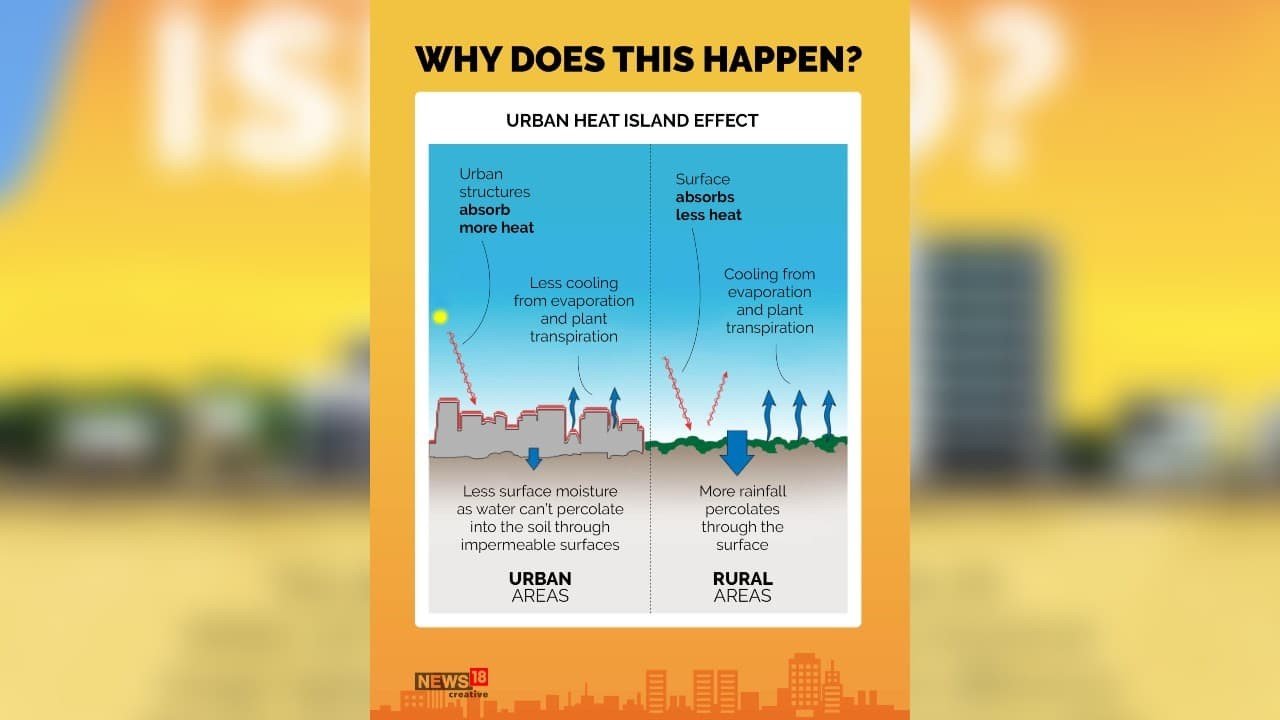Environment & Ecology
Why in News: Several parts of the country are reeling under heat wave conditions. Cities, especially, are a lot hotter than rural areas.
- 15th May 2022: Two areas in Delhi recorded temperatures close to 50 degrees Celsius. Temperatures around these cities, however, were not as high.
- This is due to a phenomenon called an “urban heat island”. The sun’s heat and light reach urban and rural areas in the same way but the difference in temperature is mainly because of the surfaces in each environment and how they absorb and hold heat
NASA’s Observation
NASA’s Ecosystem Spaceborne Thermal Radiometer Experiment (Ecostress) captured an image shortly before midnight of May 5, covering an area of about 12,350 square kilometres, which showed a large red patch around Delhi and smaller red patches around neighbouring cities of Sonipat, Panipat, Jind and Bhiwani. These red patches, implying higher temperatures, were the heat islands, while the rural areas around the cities witnessing lower temperatures.
- Ecostress is an instrument with a radiometer, can measure temperatures on the ground, as opposed to the air temperature.
- Tasked with measuring the temperature of plants and understanding their water requirements and the impact of the climate on them.
What is an Urban Heat Island (UHI)?
- A local and temporary phenomenon experienced when certain pockets within a city experience higher heat load than surrounding or neighbouring areas on the same day.
- The variations are mainly due to heat remaining trapped within locations that often resemble concrete jungles.
- The temperature variation can range between 3 to 5 degrees Celsius.
Why are cities hotter than rural areas?
Rural areas have relatively larger green cover in the form of plantations, farmlands, forests and trees as compared to urban spaces.
- This green cover plays a major role in regulating heat in its surroundings.
- Transpiration is a natural way of heat regulation: This is the scientific process of roots absorbing water from the soil, storing it in the leaves and stems of plants, before processing it and releasing it in the form of water vapour.
On the contrary, urban areas lack sufficient green cover or gardens and are often developed with high-rise buildings, roads, parking spaces, pavements and transit routes for public transport.
- As a result, heat regulation is either completely absent or man-made.
- Black or any dark coloured object absorbs all wavelengths of light and converts them to heat, while white reflects it.
- Cities usually have buildings constructed with glass, bricks, cement and concrete — all of which are dark-coloured materials, meaning they attract and absorb higher heat content.
- Water cannot flow easily through/via them
- Without a cycle of flowing and evaporating water, these surfaces have nothing to cool them down.
- Heat is also released by numerous human activities – vehicles, factories, household appliances, release heat in the environment and cause a spike in temperature.
Thus, forms temporary islands within cities where the heat remains trapped. These are urban heat islands that record higher day temperatures than other localities.
Impacts of UHI
Power/Energy costs: Increases energy costs (e.g., for air conditioning), air pollution levels, and heat–related illness and mortality.
Poor water and air quality: As there are more pollutants, they are blocked from from scattering and becoming less toxic by the urban landscape. Warm water from the UHI stresses the native species that have adapted to life in a cooler aquatic environment.
Colonization by heat-loving species: UHI increases the colonization of species that like warm temperatures, such as lizards and geckos. Insects such as ants are more abundant here than in rural areas; these are referred to as ectotherms.
Heatwaves: Affect human and animal health, leading to exhaustion, dehydration and increased mortality rate.
How can urban heat islands be reduced?
- By increasing the green cover: filling open spaces with trees and plants.
- Appropriate choice of construction materials
- Promoting terrace and kitchen gardens
- Painting white or light colours on terraces wherever possible to reflect heat.

Previous Year Questions (PYQs)
Q.1) Bring out the causes for the formation of heat islands in the urban habitat of the world (5 marks, 100 words) (UPSC Mains 2013)
Source: Indian Express














